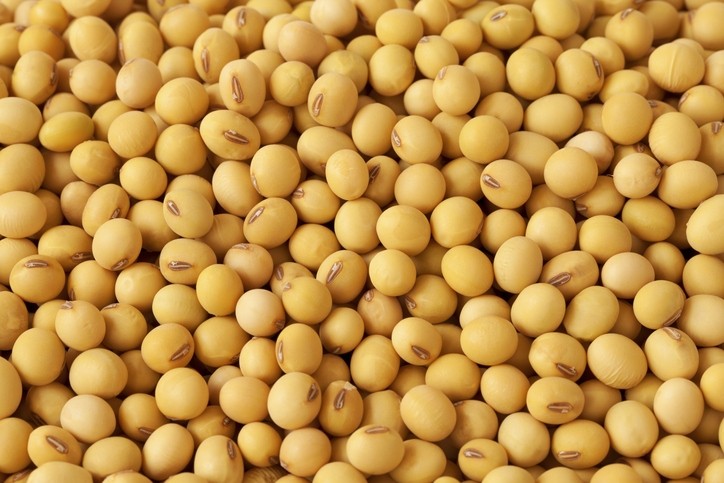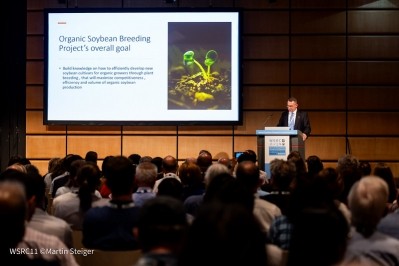Trypsin inhibitor exposure could result from using alternative soybean ingredients in feed

The development could reduce feed quality for pigs, poultry, and ruminants.
“With the rise in use of alternative soybean ingredients, routine monitoring is something that anyone involved in feed manufacturing should be considering,” said Rob Patterson, VP of innovation and commercialization, at Canada-based CBS Bio Platforms. “An important first step is to understand the different detection options available, in order to choose the best fit for your specific situation and needs.”
The world is currently experiencing a high-cost soybean meal environment, driven by multiple factors including supply-demand disruption due to ongoing transportation congestion, escalating input prices such as fertilizer, as well as supply-demand imbalances due to geopolitical conflicts. Together these factors have pushed soybean meal prices to levels not seen in many years, noted the executive.
"This price pressure has led many feed producers to evaluate the use of non-traditional soybean products such as whole or full fat soybeans that have been cooked, pressed or extruded in one way or the other."
CBS Bio Platforms flagged its strong feed science network, stressing how it has kept a close eye on implications of the increasing use of ingredients, including the question of whether trypsin inhibitor exposure is being overlooked.
“The advantages these ingredients have are that they are typically produced in proximity to where feed is manufactured, reducing transportation costs and in recent years have become more consistent in their nutrient composition due to advancements in the equipment used to process the raw beans. However, there is one problem that many involved have overlooked when they begin to evaluate or use non-traditional soybean ingredients and that is the presence and level of trypsin inhibitors (TI) in these products," said Patterson.
The use of these alternative protein sources may be inadvertently exposing livestock to anti-nutritional toxins that could be depressing performance and offsetting the savings sought out by using such protein sources, he maintains.
Trypsin inhibitors
Trypsin inhibitors are natural anti-herbivore enzymatic compounds produced by soybeans and other legumes that, eponymously, block the production of the digestive enzyme trypsin. Trypsin is an important enzyme for protein digestion and when not produced in sufficient quantities, undigested protein lingers in the GIT which leads to bacterial overgrowth, fermentation of undesired compounds and diarrhea.
"Excessive exposure to TI, in addition to reducing nutrient absorption through diarrhea generation, also reduces the total plane of health thereby making animals more susceptible to enteric disease infection as well as exacerbating mycotoxicosis. So, the knock-on effects associated with TI exposure should not be ignored, as taken together, all negative outcomes will lead to reduced performance and profitability,” continued Patterson.
Historically, trypsin inhibitors have been managed in conventional soybean meal through the heating process involved in removing oil via solvent extraction, thereby deactivating trypsin inhibitors by denaturation.
“In non-conventional soybean products, heat applied via extrusion, toasting, or pressing has been assumed to be sufficiently high and applied for a long enough duration so as to deactivate trypsin inhibitors to a non-problematic level. However, the bespoke nature by which non-conventional soybean products are produced lends itself to greater batch-to-batch variability, which in turn leads to more variable levels of trypsin inhibitor levels.
“Combine this inherent manufacturing variability with more widespread adoption and it becomes clear that a problem, i.e., TI exposure, that for the better part of three decades was thought to be managed, could be something that is being overlooked and could be a factor contributing to reduced growth performance and profitability.”
Detection
In terms of what can be done to manage the risk of TI exposure that accompanies the use of non-convention soybean products, Patterson said the first course of action is to focus on detection - understanding the process by which a product is produced and implementing routine testing for each batch received is one way in which TI levels can begin to be managed.
Secondly, it is important to restrict exposure, he said.
"Setting limits within a formulation system based on batch-to-batch testing can reduce the risk of over-exposing livestock to dietary TI. Lastly, treatment options can be implemented or when already in place, relied upon, whereby heat can be applied to the feed via pelleting, extrusion, or expansion in order to deactivate TI from non-conventional soybean ingredients.”
Laboratory analysis
There are also options available to allow for continuous monitoring, which is the backbone of any successful risk management program for trypsin inhibitors, added Patterson.
Having samples analyzed in a laboratory is one of the main options, involving two basic methods, he said. The first and most commonly used is the urease method, which does not detect TI directly but rather detects residual urease, a marker for TI levels.
“The premise of this method is that urease is equally susceptible to heat and processing denaturation as TI. Therefore, any urease that survives processing will be equivalent to the residual content of TI,” he explained.
The second laboratory method is known as the direct method. “This method differs from the urease method in that residual TI in the sample of interest are extracted and measured through a colorimetric inhibition assay in order to give a direct quantification of the TI present in the sample.”
Each of the two laboratory methods has distinct advantages and disadvantages, he notes. The urease method is less expensive and more practical – it can be run at a commercial lab as well on site at processing facilities that possess basic quality control laboratories. However, as the urease method is a proxy assay, it is susceptible to external interference.
The direct method, while less susceptible to this interference, requires the use of more sophisticated instrumentation and is more expensive. It involves purchasing, storing and managing expensive reagents, and typically is run by experienced and proficient technicians. “These requirements drive up both the implementation and per sample costs of this method and as such is not readily made available at most commercial laboratories.”
Rapid kits
An alternative to relying on third party labs for TI analysis is the use of rapid detection kits. “There are a number of options available at the moment and for the most part, each kit relies on the fundamentals of the urease method to detect TI.”
With rapid detection kits, samples can be analysed nearly anywhere with results obtained in hours versus days at substantially less cost, he notes. “However, rapid detection kits don’t have the same precision nor are they able to detect TI at low levels to the same degree as lab-based methods.
There is also a degree of subjectivity that accompanies the use of rapid kits as they rely on the user to assess color change or color formation, said Patterson. Because of this, he recommends that rapid test kits should be considered a tool or a component of a broader monitoring program that also includes either of the two lab-based TI analysis methods.











